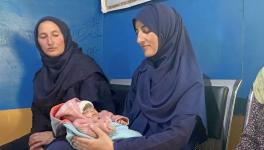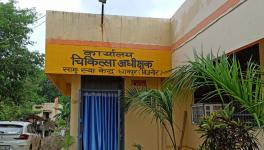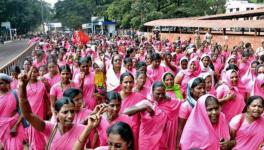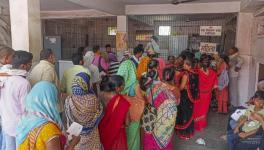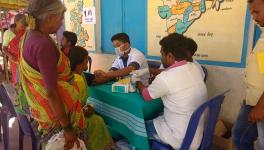India’s Covid-19 Vaccination Programme Reveals Need for a More Just Allocation among States
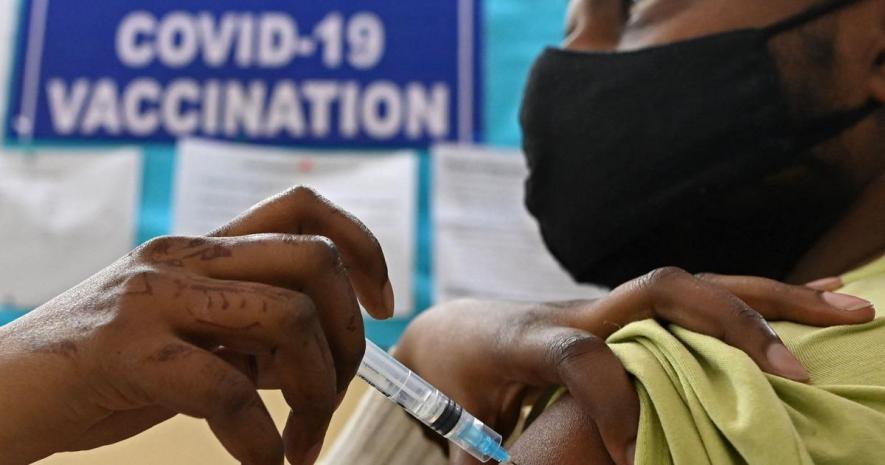
Image Courtesy: AFP
Some states in India are recording a larger proportion of fully vaccinated population than others. An analysis of vaccination rates across states in India sheds light on some aspects of why there is a difference in this rate.
The current vaccination trend shows that some of the richer states in India have fully vaccinated (that is, giving the recommended two doses of the vaccine) a higher percentage of their population than the relatively poorer states.
Figure 1 shows the link between the states’ per capita income and their respective rates of full vaccination. The per capita income is represented by the per capita Net State Domestic Product and vaccination rate is calculated as the proportion of fully vaccinated people in a state to its total population.
In the above figure, States such as Delhi (DL), Kerala (KR), Gujarat (GJ), and Goa (GO), are located in the upper right portion of the graph and have a higher per capita income. As on June 16, they had also vaccinated a higher proportion of their population - 7.3%, 6.7%, 6.7%, and 6.4% respectively.
On the other hand, Bihar (BH), Uttar Pradesh (UP), Jharkhand (JH), located at the bottom left corner of the graph depicting lower per capita income as well as lower rates of vaccination. Till June 16, Bihar and UP had fully vaccinated only 1.6% and 1.7% of their populations while in Jharkhand the rate was 2.2%.
These relatively richer States are also relatively more urbanised. Some analyses within select States, has shown that the vaccination drives are concentrated in urban areas. This translates into a rural-urban divide, reflecting that poorer states could be registering lower rates of vaccination due to a predominance of rural areas. In Bihar, for instance, Dr. Shakeel-ur-Rahman, convenor of Jan Swasthya Abhiyan, Bihar, explains that “It is more of an issue of governance. States such as UP and Bihar have been faring poor on a number of counts – infrastructure, human resources and the other requisites needed to vaccinate the population. When the supply of vaccines is limited, the access by poorer sections will get adversely affected. Moreover, while vaccination is being carried out in Patna at a much better rate, a poorer district such as Araria lags behind.”
Other Sources of Inequity
Vaccination rate is also higher in states that have attained a higher education level. Figure 2 depicts a link between rate of vaccination and the level of education in the states. The education index is a combined measure of average adult years of schooling and expected years of schooling (measured as part of the Human Development Index).
The figure shows that states such as Kerala, Goa, Delhi, and Himachal Pradesh, which have better score in the education index, have also been able to achieve higher rates of full vaccination. On the other hand, Bihar, UP, Jharkhand, and Madhya Pradesh (located in the bottom left hand corner), which have lower scores in the education index, have lower rates of vaccination.
The link between education and vaccination rates, Dr. Shakeel says, is quite straightforward. “In Bihar, for example, such linkages have also been observed in other parametres such as the Total Fertility Rate,” he says.
Further, the data also shows that the states having a higher number of internet subscribers per 100 people, such as Delhi (200), Himachal Pradesh (83), and Kerala (77) have also shown a relatively higher population getting vaccinated.
These linkages show that the current vaccination programme has not been able to circumvent the inequities prevalent in the system and has rather got affected by these inequities. The health system in India is plagued with inequities in access. These inequities emerge on a number of counts such as income, region and education level.
Arbitrary Policies
The unplanned vaccination policies being pursued by the Central government have only worsened things.
Up to April 30, the procurement and distribution of vaccines to states was governed by the Centre. From May 1, the government launched a liberalised and accelerated vaccination programme under which the Centre was procuring 50% of the vaccines and providing them to the states. From the remaining 50% vaccine pool, the state governments and private hospitals could directly procure. From June 21, the policy will revert to the central procurement and distribution with 25% being open for the private sector procurement.
The liberalised policy, in place from May 1 to June 21, aggravated the inequities in terms of the percentage population in states getting vaccinated. Between April 30 and June 16, while Delhi increased the proportion of vaccinated population from 3.4% to 7.3% and Gujarat from 3.6% to 6.7%, and Kerala from 3.7% to 6.7%, Bihar and UP could only increase it from about 1% to 1.7%.
In a recent report published in The Hindu, an RTI enquiry revealed that there is an unequal distribution of vaccines from the Centre to the states. While the rate of utilisation is high in states such as Uttar Pradesh, Bihar, and Tamil Nadu, they face a crunch in vaccine supply. On the other hand, states such as Chhattisgarh, Himachal Pradesh and Gujarat have higher vaccine stocks.
According to professor Tejal Kanitkar, faculty at National Institute of Advanced Studies, Bengaluru, with vaccine shortages continuing for some more months, the strategy of keeping 25% of the doses reserved for private hospitals and centres will further exacerbate the vaccine inequality that we have already seen across the country.
Criteria-based Distribution?
According to the revised guidelines issued on June 8 for the National Covid Vaccination Programme, vaccine doses provided free of cost by Government of India will be allocated to States/UTs based on criteria such as population, disease burden and the progress of vaccination. Wastage of vaccine will affect the allocation negatively. These guidelines will come into effect from June 21.
As the vaccine inequities have increased over the months, the government needs to come up with a clear basis for vaccine distribution among states. Ravi Duggal, health researcher and activist associated with the Peoples Health Movement, suggests that “it is not difficult to arrive at a formula on the basis of which the government can ensure equitable supply of vaccines. For instance, a formula can be devised by including such indicators as infection rate, total population, and share of urban population with appropriate weightage given to each.”
Dr. Shakeel, however, expressed his apprehensions towards employing the criterion of vaccine wastage. According to him, penalising states on the basis of vaccine wastage would work against those states, which lack adequate wherewithal to administer vaccines.
In order to ensure that there is equity in the distribution of vaccines across states and also among different sections of the population, the government will have to proactively work to tackle the inequities in vaccine distribution.
Prof. Kanitkar suggests, “The government must declare a just and objective criteria for vaccine allocation to states, arrived at via consultation with health sector experts and state governments in a transparent manner.”
Get the latest reports & analysis with people's perspective on Protests, movements & deep analytical videos, discussions of the current affairs in your Telegram app. Subscribe to NewsClick's Telegram channel & get Real-Time updates on stories, as they get published on our website.













